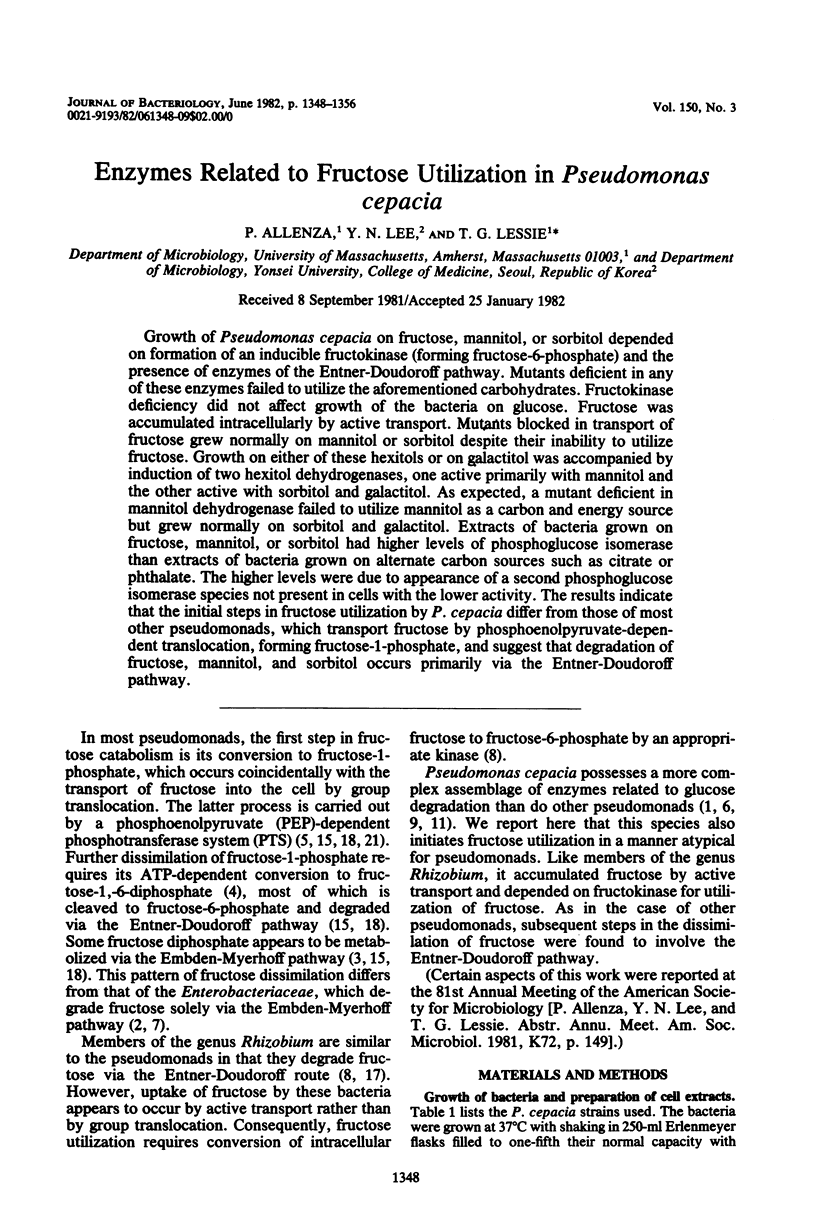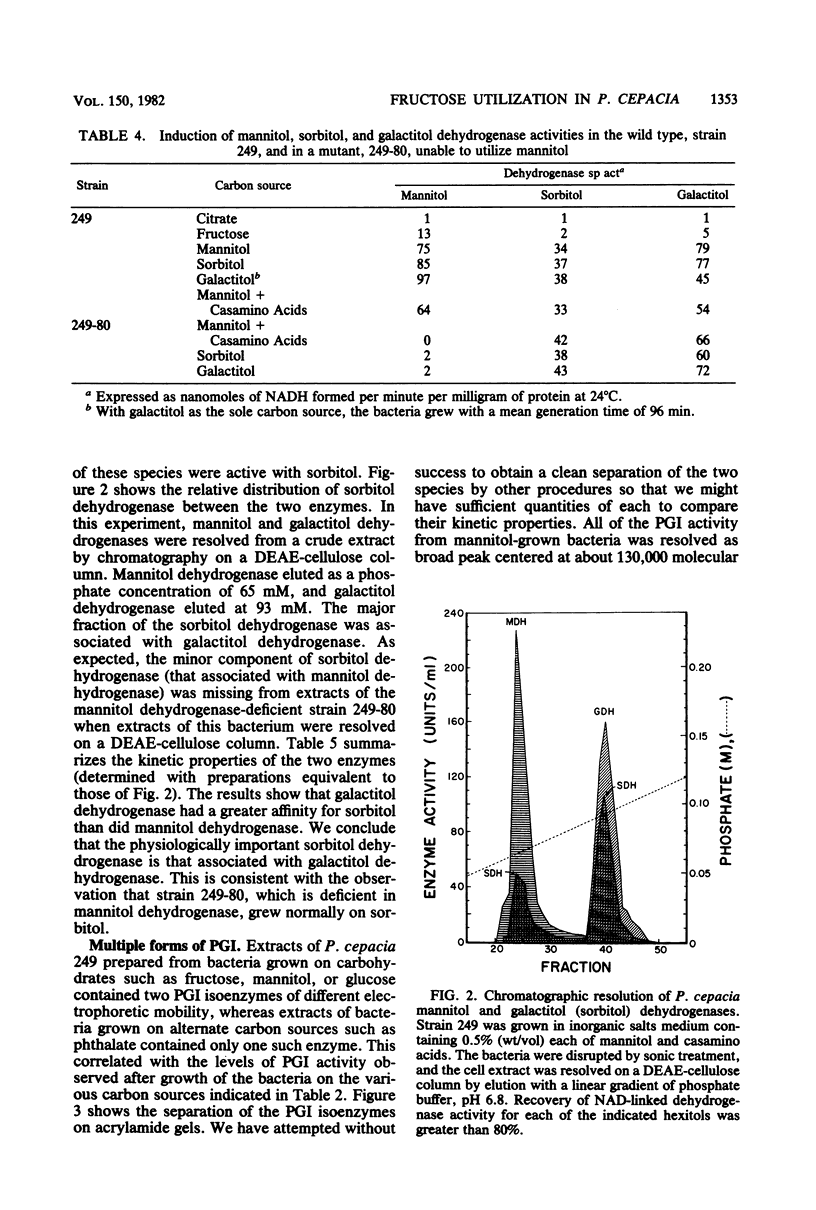Abstract
Growth of Pseudomonas cepacia on fructose, mannitol, or sorbitol depended on formation of an inducible fructokinase (forming fructose-6-phosphate) and the presence of enzymes of the Entner-Doudoroff pathway. Mutants deficient in any of these enzymes failed to utilize the aforementioned carbohydrates. Fructokinase deficiency did not affect growth of the bacteria on glucose. Fructose was accumulated intracellularly by active transport. Mutants blocked in transport of fructose grew normally on mannitol or sorbitol despite their inability to utilize fructose. Growth on either of these hexitols or on galactitol was accompanied by induction of two hexitol dehydrogenases, one active primarily with mannitol and the other active with sorbitol and galactitol. As expected, a mutant deficient in mannitol dehydrogenase failed to utilize mannitol as a carbon and energy source but grew normally on sorbitol and galactitol. Extracts of bacteria grown on fructose, mannitol, or sorbitol and higher levels of phosphoglucose isomerase than extracts of bacteria grown on alternate carbon sources such as citrate or phthalate. The higher levels were due to appearance of a second phosphoglucose isomerase species not present in cells with the lower activity. The results indicate that the initial steps in fructose utilization by P. cepacia differ from those of most other pseudomonads, which transport fructose by phosphoenolpyruvate-dependent translocation, forming fructose-1-phosphate, and suggest that degradation of fructose, mannitol, and sorbitol occurs primarily via the Entner-Doudoroff pathway.
Full text
PDF








Selected References
These references are in PubMed. This may not be the complete list of references from this article.
- Allenza P., Lessie T. G. Pseudomonas cepacia mutants blocked in the Entner-Doudoroff pathway. J Bacteriol. 1982 Jun;150(3):1340–1347. doi: 10.1128/jb.150.3.1340-1347.1982. [DOI] [PMC free article] [PubMed] [Google Scholar]
- Anderson R. L., Wood W. A. Carbohydrate metabolism in microorganisms. Annu Rev Microbiol. 1969;23:539–578. doi: 10.1146/annurev.mi.23.100169.002543. [DOI] [PubMed] [Google Scholar]
- Bang S. S., Baumann P., Sawyer M. H. Properties of 1-phosphofructokinase from Pseudomonas putida. Can J Microbiol. 1977 Jun;23(6):721–725. doi: 10.1139/m77-108. [DOI] [PubMed] [Google Scholar]
- Baumann P., Baumann L. Catabolism of D-fructose and D-ribose by Pseudomonas doudoroffii. I. Physiological studies and mutant analysis. Arch Microbiol. 1975 Nov 7;105(3):225–240. doi: 10.1007/BF00447141. [DOI] [PubMed] [Google Scholar]
- Cacciapuoti A. F., Lessie T. G. Characterization of the fatty acid-sensitive glucose 6-phosphate dehydrogenase from Pseudomonas cepacia. J Bacteriol. 1977 Nov;132(2):555–563. doi: 10.1128/jb.132.2.555-563.1977. [DOI] [PMC free article] [PubMed] [Google Scholar]
- Gardiol A., Arias A., Cerveñansky C., Gaggero C., Martínez-Drets G. Biochemical characterization of a fructokinase mutant of Rhizobium meliloti. J Bacteriol. 1980 Oct;144(1):12–16. doi: 10.1128/jb.144.1.12-16.1980. [DOI] [PMC free article] [PubMed] [Google Scholar]
- LOWRY O. H., ROSEBROUGH N. J., FARR A. L., RANDALL R. J. Protein measurement with the Folin phenol reagent. J Biol Chem. 1951 Nov;193(1):265–275. [PubMed] [Google Scholar]
- Lee Y. N., Lessie T. G. Purification and characterization of the two 6-phosphogluconate dehydrogenase species from Pseudomonas multivorans. J Bacteriol. 1974 Dec;120(3):1043–1057. doi: 10.1128/jb.120.3.1043-1057.1974. [DOI] [PMC free article] [PubMed] [Google Scholar]
- Lessie T. G., Berka T., Zamanigian S. Pseudomonas cepacia mutants blocked in the direct oxidative pathway of glucose degradation. J Bacteriol. 1979 Jul;139(1):323–325. doi: 10.1128/jb.139.1.323-325.1979. [DOI] [PMC free article] [PubMed] [Google Scholar]
- Lessie T. G., Wyk J. C. Multiple forms of Pseudomonas multivorans glucose-6-phosphate and 6-phosphogluconate dehydrogenases: differences in size, pyridine nucleotide specificity, and susceptibility to inhibition by adenosine 5'-triphosphate. J Bacteriol. 1972 Jun;110(3):1107–1117. doi: 10.1128/jb.110.3.1107-1117.1972. [DOI] [PMC free article] [PubMed] [Google Scholar]
- Phibbs P. V., Jr, Eagon R. G. Transport and phosphorylation of glucose, fructose, and mannitol by Pseudomonas aeruginosa. Arch Biochem Biophys. 1970 Jun;138(2):470–482. doi: 10.1016/0003-9861(70)90371-1. [DOI] [PubMed] [Google Scholar]
- Phibbs P. V., Jr, McCowen S. M., Feary T. W., Blevins W. T. Mannitol and fructose catabolic pathways of Pseudomonas aeruginosa carbohydrate-negative mutants and pleiotropic effects of certain enzyme deficiencies. J Bacteriol. 1978 Feb;133(2):717–728. doi: 10.1128/jb.133.2.717-728.1978. [DOI] [PMC free article] [PubMed] [Google Scholar]
- Pradhan P. G., Nadkarni G. B. Functional multiplicity of phosphoglucose isomerase from Lactobacillus casei. Biochim Biophys Acta. 1980 Oct;615(2):465–473. doi: 10.1016/0005-2744(80)90512-4. [DOI] [PubMed] [Google Scholar]
- Sawyer M. H., Baumann P., Baumann L., Berman S. M., Cánovas J. L., Berman R. H. Pathways of D-fructose catabolism in species of Pseudomonas. Arch Microbiol. 1977 Feb 4;112(1):49–55. doi: 10.1007/BF00446653. [DOI] [PubMed] [Google Scholar]
- Schreyer R., Böck A. Phosphoglucose isomerase from Escherischia coli K 10: purification, properties and formation under aerobic and anaerobic condition. Arch Microbiol. 1980 Oct;127(3):289–298. doi: 10.1007/BF00427206. [DOI] [PubMed] [Google Scholar]
- Van Dijken J. P., Quayle J. R. Fructose metabolism in four Pseudomonas species. Arch Microbiol. 1977 Sep 28;114(3):281–286. doi: 10.1007/BF00446874. [DOI] [PubMed] [Google Scholar]


